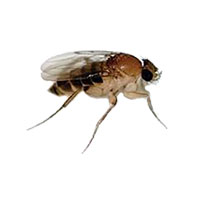Midge Fly Diet
The larvae consume decaying organic matter in water. The adults do not feed.
Midge Fly Habitat
Midges can be found along the edges of any body of water, lakes, and ponds often seeing huge congregations. Swarms of these delicate flies are common in spring and fall. Due to their poor flying ability, winds often blow them into yards where they are considered a nuisance. They may take shelter under soffits, eaves, or covered patios and are often attracted to artificial lights at night.
Midge Fly Life Cycle
Eggs are laid on the surface of the water, only to sink to the bottom where they hatch in less than a week. After hatching, larvae burrow into the mud or construct small tubes in which they live and enlarge as they grow. Organic matter in the water and mud is used as food by the developing larvae. As they grow, the larvae take on a pink color and gradually turn a dark red. The larval stage can take two to seven weeks depending on water temperature. While still in their tubes, larvae transform into pupae. After three days, pupae swim to the surface, and adults emerge several hours later. Adults mate in swarms soon after emerging. Adults do not need to feed and only live for three to five days.
Midge Fly Prevention & Control
Nutrient Reduction
Dense larval populations usually occur in nutrient-rich habitats. Fertilizer run-off from residential lawns and gardens, golf courses, and agricultural fields are sometimes responsible for the development of nuisance populations of midges.
Drain Bodies of Water
When possible, draining lakes and reservoirs with mud bottoms during winter months will kill over-wintering midge larvae, reducing the size of the adult population emerging in spring.
Diversion of Adults
High-intensity white light has been found to be highly attractive to adults. Reduce or eliminate exterior lighting by closing window blinds and turning porch lights off during heavy emergence periods to help reduce the number of adults attracted to residences and buildings.
Need help with Midge Flies?
We'll call you! Leave your information below.





